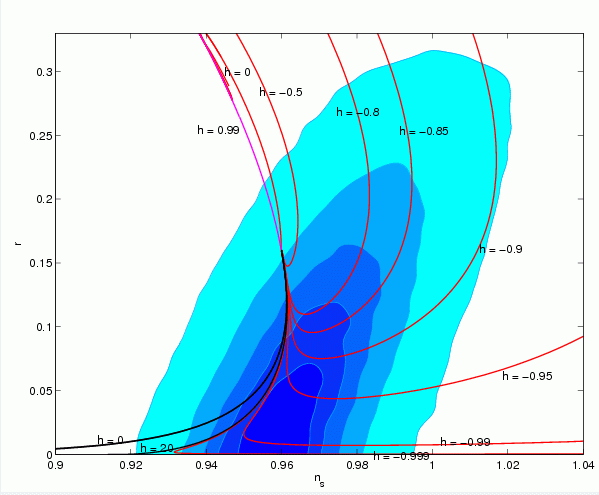The WMAP data played a key role in establishing the standard model of the universe. This model explains today a wide set of cosmological and astronomical measurements performed over a large variety of wavelenghts and observation tools : large and small angular scale CMB observations, light elements abundances, large scale structure observations (LSS) and properties of galaxy clusters, Hubble Space Telescope measurements on the Hubble constant, supernova luminosity/distance relations (acceleration of the today universe expansion), and other measurements. The concordance of these data imply that our universe is spatially flat, with gravity and cosmological perturbations described by Einstein General Relativity theory in three spatial dimensions. Our universe is at present dominated by dark energy (72%) consistent with a cosmological constant, supplemented by dark matter (about 23.4 %), and atoms (4.6 %), with density fluctuations seeded by a Gaussian, adiabatic and nearly scale invariant initial process (inflation). Dark energy acts as a form of antigravity and is responsible for the present-day acceleration of the universe. Dark matter is different from atoms, does not emit or absorb light and it has only been detected by its gravitational action. Inflation is the very primordial stage of accelerated expansion of the universe in which the universe size expands at least a factor 1026. Inflation lasts approximately 10-34 seconds and ends at a redshift 1028.
The observed CMB fluctuations are explained by inflation and the concordance model. The microscopic quantum fluctuations at the scale of inflation of 10-27 cm evolve through inflation into macroscopic fluctuations today at astronomical scales 1000 Mpc = 1027 cm. Such spectacular transition from microscopic quantum fluctuations into macroscopic classical fluctuations at astronomical scales is a proper feature to inflation.

Inflation is described by a scalar field (the inflaton) which drives the dynamics of the scale factor of the expanding universe, plus small quantum fluctuations. Inflation solves important issues of standard big bang cosmology and provides a generic mechanism for generating scalar (density) and tensor (gravitational wave) perturbations (see for instance this previous news).
Primordial gravitational waves are a robust prediction of inflation as they are produced by the same mechanism that generated the primordial density fluctuations observed in the CMB and LSS data. Recently, the team performed a new analysis with MCMC runs (Monte Carlo Markov Chains) of all available CMB and LSS data including the WMAP and Sloan data. This new analysis is achieved within the new approach to inflation as an effective theory in the Ginsburg-Landau spirit, that is with fourth degree trinomial potentials in the inflaton field. The Ginsburg-Landau approach is a powerful tool both in elementary particle physics (pion physics) and condensed matter physics (superconductivity and phase transitions). In this new analysis, the precise form of the inflationary potential is constructed by MCMC fitting the WMAP and LSS data.
The team derives explicit formulae for the CMB observables and study them : the spectral index ns of density fluctuations, the ratio r of tensor fluctuations to scalar fluctuations, and the running index d ns/dln k . These analytic formulas have been introduced as hard constraints on ns and r in the numerical programme for the MCMC analysis. This data analysis differs in this crucial aspect from all previous CMB data analysis, in particular from the WMAP analysis (including the just released (march 2008) WMAP 5 years analysis).
In the frame of their model, the new results of the team are as follows :
The data strongly indicate the breaking (whether spontaneous or explicit) of the symmetry of the inflaton potentials The trinomial inflaton potential with two minima (that is the double well potential) naturally satisfies this requirement and provides the best fit to the data The symmetric inflaton potential with only one minimum (potential with positive quadratic term) is almost certainly ruled out (at 95% CL) The preferred inflation trinomial potential is a double well, even function of the field with a moderate quartic coupling y yielding as most probable values : ns 0.958 r 0.055 . This value for r is within reach of forthcoming CMB observations A lower bound for r is found : 0.016 (95% CL) and 0.049 (68% CL). This shows that the amount of tensor fluctuations (primordial gravitational waves) is non zero, in this model. This is an important result since until now, only upper bounds for r have been found, the last being r < 0.20 ( 95% CL) of the just released WMAP 5 year data. Moreover, the lower limit on r could still be tightened with the use of the WMAP 5 year and forthcoming CMB data.

Références
- [1] "MCMC analysis of WMAP and SDSS data points to broken symmetry inflaton potentials and provides a lower bound on the tensor to scalar ratio" C. Destri, H. J. de Vega, N. G. Sanchez, Phys. Rev. D 77, 043509 (2008)
- [2] "New Inflation vs. Chaotic Inflation, Higher Degree Potentials and the Reconstruction Program in light of WMAP3" D. Boyanovsky H. J. de Vega, C. M. Ho, N. G. Sanchez, Phys. Rev. D 75, 123504 (2007)
- [3] "Clarifying Inflation Models : Slow-roll as an expansion in 1/Nefolds and No Fine Tuning", D. Boyanovsky, D. Boyanovsky, H. J. de Vega, N. G. Sanchez, Phys. Rev. D 73, 023008 (2006).
- [4] "Single Field Inflation models allowed and ruled out by the three years WMAP data", H. J. de Vega, N . G. Sanchez , Phys. Rev. D 74, 063519 (2006).
Contact
- Norma Sanchez
(Observatoire de Paris, LERMA, et CNRS)

